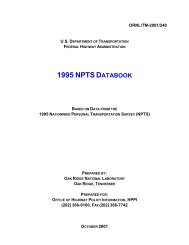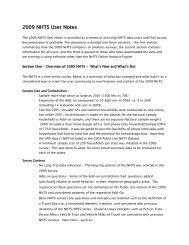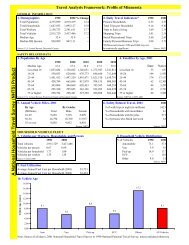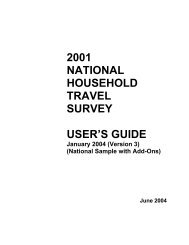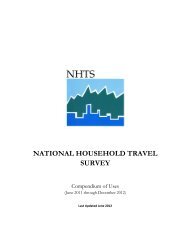Uses of National Household Travel Survey Data in - NHTS Home ...
Uses of National Household Travel Survey Data in - NHTS Home ...
Uses of National Household Travel Survey Data in - NHTS Home ...
You also want an ePaper? Increase the reach of your titles
YUMPU automatically turns print PDFs into web optimized ePapers that Google loves.
Energy Consumption<br />
The Impact <strong>of</strong> Residential Density on Vehicle Usage and Fuel Consumption<br />
Authors:<br />
Kim, J<strong>in</strong>Won; Brownstone, David<br />
University <strong>of</strong> California, Irv<strong>in</strong>e - Department <strong>of</strong> Economics, 3151 Social Science Plaza Irv<strong>in</strong>e, CA 92697<br />
; University <strong>of</strong> California Transportation Center - 2614 Dwight Way, Mail Code 1782 Berkeley, CA<br />
94720-1782 ; University Transportation Centers Program - 1200 New Jersey Avenue, SE Wash<strong>in</strong>gton,<br />
DC 20590<br />
Monograph<br />
3/1/2010<br />
Abstract:<br />
This paper <strong>in</strong>vestigates the impact <strong>of</strong> residential density on vehicle usage and fuel consumption. The<br />
empirical model accounts for both residential self-selection effects and non-random miss<strong>in</strong>g data<br />
problems. While most previous studies focus on a specific region, this paper analyzes national level data<br />
from the 2001 <strong>National</strong> <strong>Household</strong> <strong>Travel</strong> <strong>Survey</strong>. Compar<strong>in</strong>g two households that are equal <strong>in</strong> all<br />
respects except residential density, the household resid<strong>in</strong>g <strong>in</strong> an area that is 1000 hous<strong>in</strong>g units per square<br />
mile denser (roughly 50% <strong>of</strong> the sample average) will drive 1500 (7.8%) fewer miles per year and will<br />
consume 70 (7.5%) fewer gallons <strong>of</strong> fuel than the household <strong>in</strong> the less dense area. The effect <strong>of</strong> the<br />
contextual density measure (density <strong>in</strong> the context <strong>of</strong> its surround<strong>in</strong>g area) is quantitatively larger than the<br />
sole effect <strong>of</strong> residential density. A simulation mov<strong>in</strong>g a household from suburban to urban area reduces<br />
household annual mileage by 15%.<br />
Subject areas and Index Terms<br />
Energy; Highways; Operations and Traffic Management<br />
Automobile ownership; Density; Econometric models; Fuel consumption; Land use models;<br />
Socioeconomic factors; Urban sprawl; Vehicle miles <strong>of</strong> travel; California; <strong>National</strong> <strong>Household</strong> <strong>Travel</strong><br />
<strong>Survey</strong><br />
Availability: Available from UC Berkeley Transportation Library through <strong>in</strong>terlibrary loan or document<br />
delivery Order URL: http://library.its.berkeley.edu; F<strong>in</strong>d a library where document is available Order<br />
URL: http://worldcat.org/oclc/589077900<br />
12



